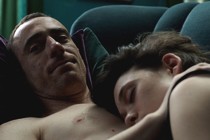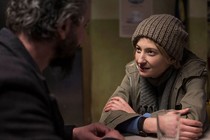Long Live the Bride: one bar, lots of stories
- VENICE 2015: Five years after The Black Sheep, Ascanio Celestini is back at Venice with an ensemble film set in the Roman suburbs, starring Alba Rohrwacher and Salvatore Striano

A bar in the suburbs, a marginalised community, a neighbourhood that seems invisible, but is crawling with stories. It is within the perimeter of four streets of the Roman district of Quadraro, near Cinecittà, that Long Live the Bride [+see also:
trailer
interview: Ascanio Celestini
film profile] unfolds, the second film of director, actor and playwright Ascanio Celestini, which is being screened in the official selection of the Venice Days section of the 72nd Venice Film Festival. Making a return to the Lido five years after The Black Sheep [+see also:
trailer
film profile] (was in competition), Celestini’s latest film brings together a diverse cast led by characters inspired by stories the director heard and people he saw in real life at a newsstand in Via Tuscolana, where he hit upon “a small working-class community that I thought no longer existed”, he explains, “but that we have to salvage and find the time to portray”.
All the characters’ daily lives revolve around a bar, but they don’t always cross paths. The thread that connects them is Nicola (Celestini), a theatrical performer who performs at children’s parties, drinks too much sambuca (but always says he’s going to quit) and takes care of Salvatore (the young Francesco De Miranda), the son of a prostitute, Anna (Veronica Cruciani), who could also be his son. One day he bumps into Sasà (Salvatore Striano), who makes ends by conning insurance companies and is training Nicola to do the same. Then love blossoms with Sofia (Alba Rohrwacher), who says she wants to run away to Spain with a friend but never leaves the neighbourhood. The director looks at these people with tenderness and humour. “It’s a community that ticks by at a slow pace, people stop off at the bar for hours on end, in an area where the city seems to end yet also re-begin”, notes Celestini. In the background, an American bride roams Italy, bringing people’s dreams to life.
In roaming between the destitute, prostitutes and tramps, always with a glass or bottle in his hand, every now and again Nicola gives us a solo performance, be it of a story, a joke or a nursery rhyme, reminding the viewer of the exceptional storytelling abilities of Celestini, just like how the puppets that pop up here and there seem to nod to the experience of this esteemed writer and stage actor turned filmmaker. Furthermore, the director does not give up on his civil commitment and touches an open nerve in one brutal scene in which the character of Sasà is beaten to death by the police. The trade union of the Italian police force, Coisp, has already heavily criticised Celestini’s film. And whilst proceedings are still underway to determine the true cause of death of Giuseppe Uva, who was beaten to a pulp at a carabinieri barracks one night seven years ago, the controversy seems to have only just begun.
Long Live the Bride is an Italian-French-Belgian co-production, produced by Malìa, Æternam Films and Les Film du Fleuve, the production company of the Dardenne brothers, with Rai Cinema and the financial backing of the Italian Ministry for Cultural Heritage and Activities and Tourism and the CNC. International sales are being handled by Fandango. The film will be released in Italy by Parthénos.
(Translated from Italian)
Did you enjoy reading this article? Please subscribe to our newsletter to receive more stories like this directly in your inbox.


























